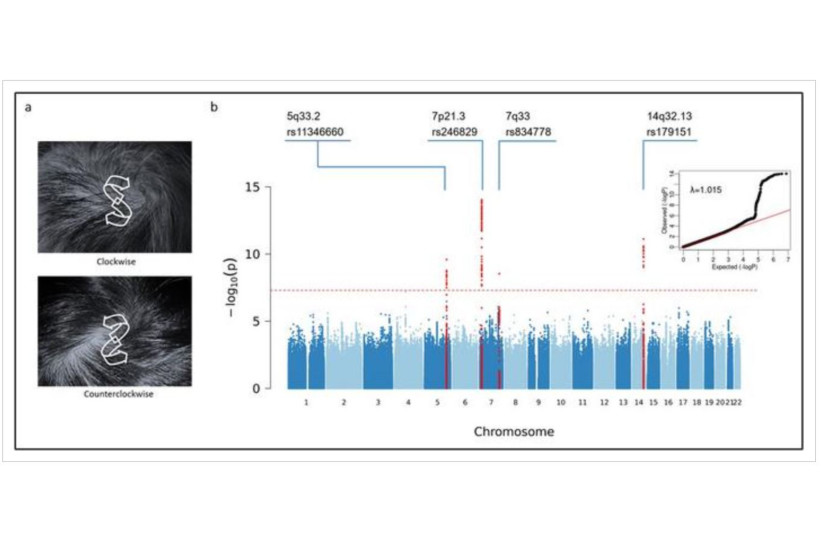A “hair whorl” – which occurs in both hairy animals such as horses on their body and head and humans on their heads – is a patch of hair growing in a circular pattern around a visible center point. Also known as crowns, swirls, or trichoglyphs, they can be either clockwise or counterclockwise in direction of growth.
A new study in the Journal of Investigative Dermatology entitled “GWASs Identify Genetic Loci Associated with Human Scalp Hair Whorl Direction” uncovers the genes that dictate the direction of hair whorls. It is the first gene-mapping study on human scalp hair whorls. The researchers showed not only that hair-whorl direction has a genetic basis, but also that it can be affected by four different gene variants.
Hair whorls on the head (parietal whorls) have been studied by some behaviorists. Most people have clockwise scalp hair-whorls. Parietal whorls that are considered to be normal scalp patterns could be a single whorl or double whorls, while cases of triple parietal whorls are less common.
The late Indian geneticist Amar J. S. Klar conducted research to see if there was a genetic link between handedness and hair-whorl direction and found that 8.4% of right-handed people and 45% of left-handed ones had counterclockwise hair-whorls. His research suggested that a single gene may control both handedness and hair-whorl direction, but unfortunately, his research methodology has been questioned.
As an easily observed human trait, scalp hair whorl pattern is typically defined by the whorl number (single or double whorl) and whorl direction (e.g., clockwise, counterclockwise, or diffuse).

Because atypical whorl patterns have been observed in patients with abnormal neurological development, understanding the genetic basis of whorl patterns could help explain vital biological processes.
First genome-wide association study on human scalp hair whorls
The first genome-wide association study (GWAS) on human scalp hair whorls was performed by lead investigator Dr. Sijia Wang of the Shanghai Institute of Nutrition and Health in the Chinese Academy of Sciences. The study looked at 2,149 people in China.
Wang explained that “we know very little about why we look like we do. Our group has been looking for the genes underlying various interesting traits of physical appearance, including fingerprint patterns, eyebrow thickness, earlobe shape and hair curliness. Hair whorl is one of the traits about which we were curious. The prevailing opinion was that hair-whorl direction is controlled by a single gene, exhibiting Mendelian inheritance. However, our results demonstrate that hair whorl direction is influenced by the cumulative effects of multiple genes, suggesting a polygenic inheritance.”
The study identifies four associated genetic variants (at 7p21.3, 5q33.2, 7q33, and 14q32.13). These genetic variants are likely to influence hair whorl direction by regulating the cell polarity of hair follicles, with cranial neural tube closure and growth also potentially playing a role.
Wang concluded that while previous work proposed the hypothesis of associations between hair whorl patterns and abnormal neurological development, no significant genetic associations were observed between hair whorl direction and behavioral, cognitive, or neurological phenotypes. Although we still know very little about why we look like we do, we are confident that curiosity will eventually drive us to the answers.”
